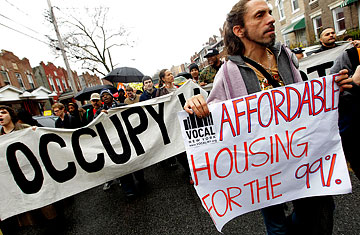
Occupy Wall Street activists march during a tour of foreclosed homes in the East New York neighborhood of the Brooklyn borough of New York, Dec. 6, 2011
Zuccotti Park is encased in barriers, looking more like a crime scene these days than a hotbed of social activism, but while the drummers and the mike checks and the signs are gone, Occupy Wall Street activists claim their ranks are growing and the movement is stronger than ever.
"It's a diaspora," says Kanene Holder, 32, who is an active member of three of Occupy Wall Street's more than 100 working groups. "The movement is spreading and sprouting everywhere like dandelion seeds. If anything, the eviction from Zuccotti Park and other occupations around the country helped clarify what this movement is about."
Whatever Occupy Wall Street (OWS) is, it has a new office two blocks from Wall Street. Since Nov. 7, activists have been quietly occupying 2,500 sq. ft. of workspace located on the 12th floor at 50 Broadway. The rent is $5,400 a month and paid for by anonymous donors. "I don't even know their names," office coordinator Bianca Bockman says of the space's backers. "There are checks being written to pay the rent."
"The workspace was funded by individuals who wanted to support OWS but were concerned about the way the General Assembly was operating," says Michael Fix, a longtime activist and documentary filmmaker who, with Bockman, helps manage the space. (The General Assembly was a daily town-hall-style meeting that started spontaneously three months ago in New York City, and which has since been replicated in other cities. Though evicted from Zuccotti Park, the General Assembly is allowed to meet in the park on Tuesdays, Thursdays, Saturdays and Sundays at 7 p.m., as long as no one brings tarps, tents or equipment that makes it look like they are about to reoccupy the space.)
The doors to the movement's office are plastered with OWS stickers. The street artist Swoon has a large piece in the back room. Another artist named Lopi LaRoe donated something for the foyer. A metallic silver Fender Telecaster leans against the wall in the conference room, which is festooned with colorful messaging. The meeting I was allowed to attend discussed matters of communication and job descriptions. The people in attendance were "spokes" (as in "of a hub"), which is movementspeak for point people, and they were chosen by the 20 working groups that are using the office. The working groups are approved at General Assembly meetings, and its self-selecting members rotate in and out based on availability.
The famously unstructured movement appears to be showing signs of structure and organization. "We're creating layers of organization so the movement can replicate itself in more places," Ed Needham from the p.r. working group says. The office is serving as one of a few spaces where groups can experiment with implementing that structural overlay.
It's not seamless.
A young man with blond hair and a panda hat announces himself at the front desk, which is vigilantly managed to make sure the 48-person occupancy limit is strictly observed (managed with 48 lanyards that hang by the door) and that no one who does not belong in the work space gains entry. One of the space's "two and a half" office coordinators asks him what brings him to the space. He is with the alternative-currency working group and needs somewhere quiet to work on a design for OWS currency. He's not on the list.
"It's not about security; it's about process," she tells the man, explaining why she can't let him in.
"Well, for me it's about getting s--- done," he insists.
A brief but intense conversation ensues. It never boils over. It is clear there is some frustration, and yet it is equally clear that the goal is to work out a solution and put egos aside. A phone call is made. They get him on the list, and he disappears into the back bullpen area, where there are a few other activists working on information and communications issues.
